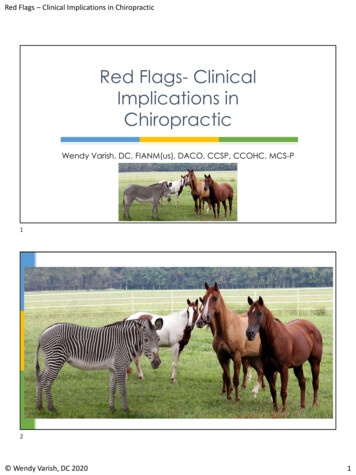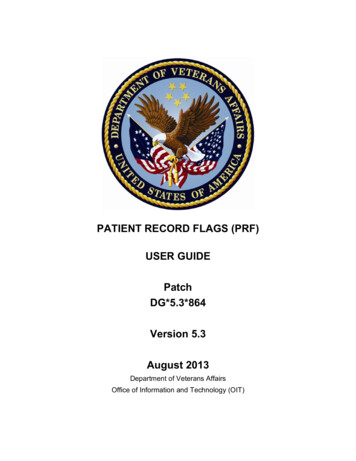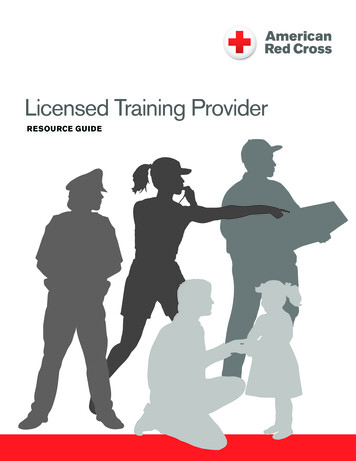
Transcription
Red Flags – Clinical Implications in ChiropracticRed Flags- ClinicalImplications inChiropracticWendy Varish, DC, FIANM(us), DACO, CCSP, CCOHC, MCS-P12 Wendy Varish, DC 20201
Red Flags – Clinical Implications in ChiropracticWendy Varish, DC, FACO, CCSP, CCOHC, MCS-PHowards Grove Chiropractic516 S. Wisconsin DriveHowards Grove, WI 53083(920) 565-3922fax (920) 565-2142wvarish@varishchiro.com3Syllabus Review of History Taking / SOAP Notes Objective assessment of Subjective Pain – Symptom Magnifier vs. Minimizer Questions that lead to treatment contraindications: pacemaker, stimulator, recent surgery, cancer diagnosis,mastectomy or lymph node removal Signs vs. SymptomsRed Flag vs. Yellow FlagRed Flag QuestionsImplications of Red Flag Responses Constitutional Changes: Unexplained night sweats, fever, fatigue, weight changes. Pain withcoughing/sneezing. Bowel / Bladder Signs/Symptoms – Cauda Equina, prostate, bladder or kidney infection, cystitis Nails, Skin, Hair Vertigo vs. dizziness, Balance Issues and Tinnitus Paresthesias – numbness/tingling Malaise / Myalgia Joint pain vs. Muscle pain Headaches – timing, frequency, intensity, location, triggers, duration Appetite, Changes in taste or smell Gait Tremors Sleep issues Proper patient/client management for CT’s and LMT’s when red or yellow flag findings are suspected4 Wendy Varish, DC 20202
Red Flags – Clinical Implications in ChiropracticSOAP Format The concept of SOAP notes was introduced by Dr.Lawrence Weed, MD in the 1960’s and 1970’s(while at the University of Vermont). Originally part of the “Problem Oriented MedicalRecord” (POMR) oqymq0.dpuf http://www.physio-pedia.com/SOAP Notes5S: Subjective: The “Story” History as expressed by the patient Obtained via “LMNOPQRSTU” or “OLD CHARTS”methods Considered subjective as it is the patient’s perception.6 Wendy Varish, DC 20203
Red Flags – Clinical Implications in ChiropracticSubjective Presenting complaint(s) – in order of severity History of presenting complaint includes other examinations, previous treatment, past referrals Past medical history significant past diseases/illnesses/conditions, surgery, includingcomplications, trauma. Medication/Supplement History now and past, prescribed and over-the-counter, Allergies tomedications* Family history Social history smoking (pack-years), alcohol use, drugs, occupation and duties,ADL’s (ability and inability), marital/family status, baselinefunctioning, occupation, pets, hobbies Systems review cardiovascular system, respiratory system, gastrointestinal system,nervous system, musculoskeletal system, genitourinary system.7O: Objective: What is “Observed” Vital Signs Test results X-ray / Imaging results8 Wendy Varish, DC 20204
Red Flags – Clinical Implications in ChiropracticA: Assessment: The “Analysis” Summary of Diagnoses How the patient is or has been responding totreatment9P: Plan:What is “Performed or Planned”***Remember . “If it was not written down, it wasnot done.”10 Wendy Varish, DC 20205
Red Flags – Clinical Implications in ChiropracticPainPain: a review of three commonly used pain ratingscales. Williamson & Hoggart; J Clin Nurs.; 2005 Aug;14(7):798-804.GOALS:Reviewed the 3 most common Pain Scales: Visual AnalogueScale, Verbal Rating Scale and Numerical Rating ScaleCONCLUSIONS: All three pain-rating scales are valid, reliable andappropriate for use in clinical practice. Visual Analogue Scale has more practical difficulties thanthe Verbal Rating Scale or the Numerical Rating Scale.1112 Wendy Varish, DC 20206
Red Flags – Clinical Implications in ChiropracticConsider askingpatient’s pain scale: At worst time of pain At least time of pain Average amount ofpain Pain right now1314 Wendy Varish, DC 20207
Red Flags – Clinical Implications in ChiropracticSymptom Magnification Definition: Symptom magnification is a self-destructive, sociallyreinforced behavioral response pattern consisting ofreports or displays of symptoms which function tocontrol the life of circumstances of the sufferer.Encyclopedia of Behavioral Medicine, 2013. pp 1945-1946 , Symptom Magnification Syndrome by Karen Jacobs15Symptom Magnification, cont. Exaggerated pain behaviors Physical examination and tests may not reveal any obviouspathology limping, moaning, groaning, and grimacing. Symptom Magnifiers tend to remain symptomatic longer, stay offwork for prolonged periods of time (if they go back at all), andoften utilize a disproportionate share of health care resources. Malingering: Conscious, deliberate deception in order to obtainsecondary gain Factitious disorder: patient seeks to occupy the sick role. Somatoform disorders: Unconscious behavior by a patient toexaggeratePSYCHOLOGY : Symptom Magnification & Waddell's Behavioral Signs By Dr. J.K., Ph.D.16 Wendy Varish, DC 20208
Red Flags – Clinical Implications in ChiropracticSymptom Minimizer vs. Magnifier https://www.youtube.com/watch?v hNfDkUk0UZI Objectify Pain via Pain Assessments FOA’s (Outcome Assessment Tools) – helpful fordetermining patient’s disabilities Examples: Roland Morris Revised Oswestry Neck Disability Index Lumbar or Cervical Bournemouth https://www.youtube.com/watch?v m PgNQY-SGk1718 Wendy Varish, DC 20209
Red Flags – Clinical Implications in ChiropracticQuestions that lead to treatmentcontraindications / precautions: Pacemaker Stimulator Recent surgery Diagnosis of Cancer Mastectomy or lymph node removal19Sign vs. Symptoms Signs are objective findings Can be reproduced Examples: blood pressure, orthopedic tests, x-rayresults Symptoms are subjective What the patient is feeling or perceives Examples: fatigue, pain, weakness Use tests to objectify subjective symptoms20 Wendy Varish, DC 202010
Red Flags – Clinical Implications in ChiropracticSignSymptom (sīn)n.Medicine An objective /symp·tom/ (simp tom) anysubjective evidence ofdisease or of a patient’scondition, i.e. suchevidence as perceived bythe patient; a change in apatient’s conditionindicative of some bodilyor mental state.finding, usually detectedon a physical examination,from a laboratory test, oron an x–ray, that indicatesthe presence ofabnormality or disease. The American Heritage Medical Dictionary:sign/symptom. (n.d.) The American Heritage MedicalDictionary. (2007). Retrieved March 6 2016from n%2fsymptom Dorland's Medical Dictionary: symptom. (n.d.) Dorland's MedicalDictionary for Health Consumers. (2007). Retrieved March 6 2016from mptom21QUIZ TIME!!!Sign or Symptom? Fever Light-headed Nauseated Nose bleeding Itching Rash Numb Fatigue Blood pressure Pallor Anxiety Low back pain Reported weakness Antalgic posture22 Wendy Varish, DC 202011
Red Flags – Clinical Implications in ChiropracticQUIZ TIME!!! Sign or Symptom?SIGNSSYMPTOMS Fever Blood pressure Pallor Antalgic posture Nose bleeding Rash Fatigue Anxiety Light-headed Nauseated Low back pain Reported weakness Itching Numb23Yellow Flags Psychosocial barriers that inhibit recovery from back pain An inappropriate perception of back pain e.g. belief that back pain is harmful and disabling Belief that passive activity such as bed rest is better thanstaying active Lack of support at home and social isolation Mental health problems such as depression, anxiety andstress Problems at work e.g. bullying, job dissatisfaction Claims for compensation and benefits24 Wendy Varish, DC 202012
Red Flags – Clinical Implications in ChiropracticYellow Flags in Back Pain--- A B C D E F W --- Attitudes Beliefs Compensation Diagnosis Emotions Family Work25Yellow Flags in Back Pain--- A B C D E F W --- Attitudes Does the patient feel or believe that with appropriatetreatment and self management they will return to normalactivities? Or do they feel they are a “lost cause”? Beliefs A belief by the patient that the problem is far worse than itactually is (e.g. cancer). Often leads to “jumping to conclusions” (catastrophizing). Compensation Is the patient expecting a payment for an accident or injuryat work?26 Wendy Varish, DC 202013
Red Flags – Clinical Implications in ChiropracticYellow Flags in Back Pain--- A B C D E F W --- Diagnosis What did the patient perceive as their diagnosis? Poor communication can lead to patients misunderstandingwhat is meant. Examples: “You have a slipped disc” or “Your spine isdegenerating and crumbling”. Emotions Patients with emotional issues such as ongoing depressionand/or anxiety are at a high risk of developing chronic pain.27Yellow Flags in Back Pain--- A B C D E F W --- Family Two problems: either over-bearing or unsupportive. Work The worse the perceived work environment, the more likely todevelop chronic pain.28 Wendy Varish, DC 202014
Red Flags – Clinical Implications in ChiropracticSTarT Back Screening Tool Tool used to assess psychosocial issues Enables the identification of those LBP patients atrisk of developing chronicity Allows the implementation of appropriate treatment. The early treatment of patients at risk ofdeveloping chronic pain has been found to beeffective at preventing long-term disability andchronicity.29The copyright ( 2007) of the STarT Back Screening Tool andassociated materials is owned by Keele University, the developmentof which was part funded by Arthritis Research UK: i) the tool isdesigned for use by health care practitioners, with appropriatetreatment packages for each of the stratified groups; ii) the tool isnot intended to recommend the use of any particular product. Nolicense is required for non-commercial use.30 Wendy Varish, DC 202015
Red Flags – Clinical Implications in Chiropractic31Red Flags during History Signs, symptoms, and features in a patient withback pain which may indicate serious spinalpathology32 Wendy Varish, DC 202016
Red Flags – Clinical Implications in ChiropracticHow Common Are Serious Causes ofBack Pain? 5% have true nerve rootpain 1% have serious diseasesuch as spinal tumor orinfection 1% have inflammatorydisease such as ankylosingspondylitis33Red Flags in Back Pain Age of onset 20yrs old or 55yrs old with NEW onset of pain Recent history of violent trauma Thoracic pain Past medical history of cancer or malignant tumor Prolonged use of corticosteroids History of Drug abuse, immunosuppression, HIV Systematically unwell Unexplained weight loss Saddle anesthesia or widespread neurological symptoms(including cauda equine syndrome) Structural deformity Unexplained Fever Constant progressive, non-mechanical pain (no relief with rest)34 Wendy Varish, DC 202017
Red Flags – Clinical Implications in ChiropracticKEY Questions to Ask to RuleOut Red Flags during History “Have you had any unexplained fever, fatigue,weight changes, night sweats or pain?” “Have you had any changes in bowel or bladder,including loss of sensation, frequency, urgency?” “Do you have any pain with coughing, sneezing, orbearing down for a bowel movement?”35Unexplained Fever Infection (20% to 40%) Bacterial: eg. Abdominal or pelvic abscesses, Dental abscesses,Endocarditis, Sinusitis, TB, UTI, etc. Viral: e.g. Cytomegalovirus, Epstein-Barr virus Malignancy (20% to 30%) Colorectal cancer, Leukemia Lymphoma (Hodgkin and non-Hodgkin) Noninfectious inflammatory disease (10% to 30%) Connective tissue diseases, Adult Still disease, Rheumatoid arthritis,Systemic lupus erythematosus ,Granulomatous disease ‘Crohn disease,Sarcoidosis, Vasculitis syndromes, Giant cell arteritis, Polymyalgiarheumatica/temporal arteritis Miscellaneous (10% to 20%) Drug-inducedFactitious feverThromboembolic diseaseThyroiditis36 Wendy Varish, DC 202018
Red Flags – Clinical Implications in ChiropracticMedications that can causeFever of Unknown Origin Anticonvulsants: Barbiturates, Carbamazepine (Tegretol), Phenytoin(Dilantin) Antihistamines: Cimetidine (Tagamet), Ranitidine (Zantac) Antimicrobials: , Carbapenems*, Cephalosporins*, Erythromycin, Isoniazid,Minocycline (Minocin), Nitrofurantoin (Furadantin), Penicillins, Rifampin,Sulfonamides* Cardiovascular drugs: Captopril (Capoten), Hydralazine,Hydrochlorothiazide, Methyldopa, Nifedipine (Procardia), Procainamide,Quinidine Nonsteroidal anti-inflammatory drugs: Ibuprofen, Salicylates, Sulindac(Clinoril) Others: Allopurinol (Zyloprim), Heparin, Meperidine (Demerol), Phenothiazines37Unexplained FeverSUBGROUPCAUSEInfection (20% to 40%)BacterialAbdominal or pelvic abscessesDental abscesses, EndocarditisSinusitis, Tuberculosis, Urinary Tract InfectionViralCytomegalovirus, Epstein-Barr virusMalignancy (20% to 30%)Noninfectious inflammatorydisease (10% to 30%)Colorectal cancer, Leukemia,Lymphoma (Hodgkin and non-Hodgkin)Connective tissue diseasesAdult Still disease, Rheumatoid ArthritisSystemic lupus erythematosusGranulomatous diseaseCrohn diseaseSarcoidosisVasculitis syndromesGiant cell arteritisPolymyalgia rheumatica/temporal arteritisMiscellaneous (10% to 20%) Drug-induced, ThroiditisFactitious fever, Thromboembolic disease38 Wendy Varish, DC 202019
Red Flags – Clinical Implications in ChiropracticUnexplained Night Sweats Menopause Idiopathic hyperhidrosis Infections Cancers Medications Hypoglycemia Hormone disorders Neurologic conditions39Red Flags with Low Back Pain:Cancer Related History of cancer Unexplained weight loss 10 kgwithin 6 months Age over 50 years or under 18 yearsold Failure to improve with therapy Pain persists for more than 4 to 6weeks Night pain or pain at rest40 Wendy Varish, DC 202020
Red Flags – Clinical Implications in ChiropracticRed Flags with Low Back Pain:Infection Related Persistent fever (Temperature over 100.4 F)History of IV Drug AbuseSevere PainLumbar Spine surgery within the last yearRecent bacterial infection Urinary Tract Infection or PyelonephritisCellulitisPneumoniaWound in spine region Systemic CorticosteroidsOrgan transplantDiabetes MellitusHuman Immunodeficiency Virus (HIV) Immunocompromised states Pain at Rest41Infection in theSpineAdult Pyogenic VertebralOsteomyelitis42 Wendy Varish, DC 202021
Red Flags – Clinical Implications in Chiropractic43Infection in theSpineTuberculosis Diskitis andOsteomyelitis44 Wendy Varish, DC 202022
Red Flags – Clinical Implications in ChiropracticInfection in theSpinePediatric Disc SpaceInfection45Red Flags: Inflammatory Back Pain Back pain associated with prolonged earlymorning spinal stiffness Symptoms improved by exercise Often starting in young people (20-30 years old) More frequent in men than women Inflammation of the eye (uveitis) is common Family history -- strong genetic association withthe gene HLAB27.46 Wendy Varish, DC 202023
Red Flags – Clinical Implications in ChiropracticInflammatory Spinal / Back Pain Most back pain is due to mechanical causes, but 1 to 2 in every1000 people will have inflammation of the spinal joints. X-rays of the spine and SI joints usually normal unless patienthad symptoms for many years MRI scan will usually show positive findings Blood tests that measure inflammation (ESR and CRP) canbe helpful but are not diagnostic. (Consider HLA-B27 too) Will always affect the SI joints, but may also affect otherparts of the spine. Causes: Ankylosing Spondylitis (most common) Psoriasis Inflammation of the bowel (Crohn's disease and ulcerative colitis)47Ankylosing Spondylitis48 Wendy Varish, DC 202024
Red Flags – Clinical Implications in Chiropractic49Bamboo Spine50 Wendy Varish, DC 202025
Red Flags – Clinical Implications in ChiropracticRed Flags:Cauda EquinaSyndrome5152 Wendy Varish, DC 202026
Red Flags – Clinical Implications in ChiropracticCauda Equina Syndrome Compression of thecentral nervesbelow the lowerend of the spinalcord (usually L1)includingcompression of thenerves to thebladder and bowel.53Cauda Equina Syndrome Typical symptoms include: Low back pain Sciatica (often in both legs) Altered sensation around the saddle” area andgenitals.54 Wendy Varish, DC 202027
Red Flags – Clinical Implications in Chiropractic Saddle Paresthesia55Cauda Equina Syndrome Bladder symptoms include: Loss of bladder sensation Abnormal sensation on passing urine Urinary retention (more common in men) Urinary incontinence (more common in women). Bowel symptoms are rare but includeincontinence. Medical Emergency!! Permanent damage may result within 6-10 hours.56 Wendy Varish, DC 202028
Red Flags – Clinical Implications in ChiropracticRed Flags: Cauda Equina Syndrome Urinary Incontinence or Retention Saddle paresthesia or anesthesia Anal sphincter tone decreasedor Fecal Incontinence Bilateral lower extremityweakness or numbness Progressive neurologic deficit Major motor weakness Major sensory deficit57Cauda Equina – a personal story https://www.youtube.com/watch?v LDk83blwHP458 Wendy Varish, DC 202029
Red Flags – Clinical Implications in ChiropracticRed Flags: Significant Herniated Disc “Sciatic” or radiating leg pain with coughing,sneezing, bearing down Major Muscle Weakness (strength 3 of 5 or less) Foot drop https://youtu.be/CuuNtaLvwA8 - next slide59Foot Drop60 Wendy Varish, DC 202030
Red Flags – Clinical Implications in ChiropracticRed Flags with Low Back Pain:Vertebral Fracture Prolonged use of Corticosteroids Age greater than 70 years History of Osteoporosis Mild Trauma over age 50 years (orwith Osteoporosis) Recent significant Trauma at any age Ejection from motor vehicle Fall from substantial height61Compression Fracture62 Wendy Varish, DC 202031
Red Flags – Clinical Implications in ChiropracticRed Flags with Low Back Pain:Abdominal Aortic Aneurysm Abdominal pulsating mass Atherosclerotic vascular disease Pain at rest or nocturnal pain Age greater than 60 years6364 Wendy Varish, DC 202032
Red Flags – Clinical Implications in ChiropracticAbdominal AorticAneurysm65Red Flags: General(weak/poor Test Specificity) Vertebral tenderness Limited spine range of motion66 Wendy Varish, DC 202033
Red Flags – Clinical Implications in ChiropracticSummary to Ask Patients (Red Flags)“Have you had, or do you have . a fever of 100.4ºF or above unexplained weight loss swelling of the back constant back pain that does not ease after lying down orresting pain in chest or high up in your back pain down legs and below the knees pain caused by a recent trauma or injury to back loss of bladder control inability to pass urine loss of bowel control numbness around genitals, buttocks or back pain that is worse at night67TUNA FISHTraumaUnexplained weight lossNeurological signsAge 50FeverIntravenous drug useSteroids for long timeHistory of cancer68 Wendy Varish, DC 202034
Red Flags – Clinical Implications in ChiropracticQUICK REVIEW:Questions to Ask to Rule OutRed Flags during History “Have you had any unexplained fever, fatigue,night sweats, weight changes, or pain?” “Have you had any changes in bowel or bladder,including loss of sensation, frequency, urgency?” “Do you have any pain with coughing, sneezing, orbearing down for a bowel movement?”6970 Wendy Varish, DC 202035
Red Flags – Clinical Implications in ChiropracticDizziness A non-specific term Includes vertigo, syncope (i.e.fainting), and non-syncope vertigo All related to the sense of balance71Vertigo Often triggered by a positionalchange of the patient’s head. Includes feelings of: Spinning, Tilting, Swaying,Unbalanced, being pulled to onedirection Other symptoms may include: Nausea, Abnormal or jerkingeye movements (nystagmus),Headache, Sweating, Ringing inthe ears or hearing loss Symptoms can last a few minutes toa few hours or more and may comeand go.72 Wendy Varish, DC 202036
Red Flags – Clinical Implications in ChiropracticCauses of Vertigo Inner ear issues Benign Positional Vertigo (BPV) Meniere's disease Also associated with ringing in the ears (tinnitus)and hearing loss. Vestibular neuritis or labyrinthitis (viral infection) Head or neck injury Stroke Tumor Certain medications (caffeine, certain antibiotics,nicotine) Migraine headaches MS (Multiple Sclerosis)73Tremors74 Wendy Varish, DC 202037
Red Flags – Clinical Implications in ChiropracticWhat is a Tremor?*per National Institute of Neurologic Disorders and Stroke “An unintentional, rhythmic muscle movement involvingto-and-fro movements (oscillations) of one or more partsof the body.” Can affect the hands, arms, head, face, voice, trunk,and legs. Most common in hands. May be symptom of: A neurological disorder A side effect of certain drugs. Not life-threatening May be embarrassing or make it harder to perform daily tasks.75Causes of Tremors Neurological disorders or conditions Multiple sclerosis, stroke, traumatic brain injury, andneurodegenerative diseases Side effect of certain drugs e.g. amphetamines, corticosteroids, and drugs used forcertain psychiatric disorders Alcohol abuse or withdrawal Mercury poisoning Overactive thyroid Liver failure Genetic Insidious76 Wendy Varish, DC 202038
Red Flags – Clinical Implications in ChiropracticTypes of Tremors Resting tremor Often seen in patients with Parkinson’s disease Action tremor Postural tremor occurs when the person maintains a position against gravity, such as holdingthe arms outstretched. Kinetic tremor appears during movement of a body part, such as moving the wrists up anddown Intention tremor present during a purposeful movement toward a target, such as touching afinger to one’s nose during a medical exam Task-specific tremor appears when performing highly skilled, goal-oriented tasks such ashandwriting or speaking Isometric tremor occurs during a voluntary muscle contraction that is not accompanied by anymovement.https://www.youtube.com/watch?v xVRKO-Sz0x477EssentialTremor78 Wendy Varish, DC 202039
Red Flags – Clinical Implications in ChiropracticPosture – Clinical Implications7980 Wendy Varish, DC 202040
Red Flags – Clinical Implications in Chiropractic8182 Wendy Varish, DC 202041
Red Flags – Clinical Implications in Chiropractic8384 Wendy Varish, DC 202042
Red Flags – Clinical Implications in Chiropractic8586 Wendy Varish, DC 202043
Red Flags – Clinical Implications in Chiropractic87Pronation vs. Supination88 Wendy Varish, DC 202044
Red Flags – Clinical Implications in Chiropractic89Limping in Children May be painful, butoften asymptomatic Need to look at the hip! Transient Synovitis Infection Legg-Calve Perthes SCFE90 Wendy Varish, DC 202045
Red Flags – Clinical Implications in Chiropractic91Antalgic or Unsteady Gait Inflammatory Joint Diseases Bone and Joint Infection Neurologic, Muscle or Tendon Diseases MS Parkinson’shttps://www.youtube.com/watch?v sjroLu-W1mEhttps://www.youtube.com/watch?v j86omOwx0Hk –later slide Trauma Congenital Diseases Myopathichttps://www.youtube.com/watch?v YlNQK7Zhb6w - next slide Footwear92 Wendy Varish, DC 202046
Red Flags – Clinical Implications in ChiropracticCongenital –Myopathic Gait93Antalgic Gait due to Pain94 Wendy Varish, DC 202047
Red Flags – Clinical Implications in ChiropracticAntalgic Gait https://www.youtube.com/watch?v jH2Fp8AH5p4 due to Trauma, osteoarthritis, Legg-Calve Perthes, SCFE95Ataxic Gait with Cerebral Palsy96 Wendy Varish, DC 202048
Red Flags – Clinical Implications in ChiropracticProgression of Parkinson’s Gait97Parkinson’s Gait - Advanced98 Wendy Varish, DC 202049
Red Flags – Clinical Implications in ChiropracticGuillain Barre Syndrome99Multiple Sclerosis – early signs100 Wendy Varish, DC 202050
Red Flags – Clinical Implications in ChiropracticEyes Exophthalmos (Bulging Eyes) Associated with Graves’ Disease(common cause ofhyperthyroidism).101Nystagmus vs. StrabismusNystagmushttps://www.youtube.com/watch?v 84bM5FxhZNsStrabismus102 Wendy Varish, DC 202051
Red Flags – Clinical Implications in ChiropracticPtosis Unilateral or Bilateral CN III Palsy: Children: Congenital, Trauma,Inflammation, Viral infection, Migraine,tumor Adults: Aneurysm, Diabetes, Neuritis,Trauma, Infection, Tumor Myasthenia Gravis103Ptosis104 Wendy Varish, DC 202052
Red Flags – Clinical Implications in ChiropracticThroat Goiter105Thyroid Issues Hyperthyroidism Hypothyroidism106 Wendy Varish, DC 202053
Red Flags – Clinical Implications in dy weightWeight gainWeight lossTemperature sensitivityIntolerant to coldIntolerant to heatHeart rateSlow heart rate (bradycardia)Fast heart rate (tachycardia)Blood pressureHypertension or ingInfertility, loss of libido, and erectiledysfunctionInfertility, loss of libido, erectile dysfunction,and spontaneous abortionEnergy levelsLow energy, fatigue, sleepinessFatigued but hyperactive – cannot sit stillBowel movementsConstipationDiarrheaMental stateDepression, poor memory, and inability toconcentrateAnxious, irritable, and nervousFluid accumulationLeg, hands, eyelid swelling, fluid around the Ankle swelling, feet and toes may also belungs (pleural effusion) and heart (pericardial swolleneffusion), abdominal swelling,round, puffyfaceSkin and hairDry, pale skin, coarse, dry hair, purple-tinged Sweaty skin, warm and smooth skin,lips, itchy skin, hair loss, loss of lateralthinning skin, pigmentation, itchy skin, haireyebrow, red rash with lines ofloss, redness of palmshyperpigmentationReflexesDelayed relaxation of reflexesMenstrual cyclesHeavy flow and prolonged or frequent periods Light flow with absent or infrequent periodsMuscle and movementsMuscle stiffness, slow to relax, aches andpainsOveractive reflexesTremors and muscle weakness107Skin Jaundice Due to Yellowing of theskin from bilirubinaccumulated in the skin –most commonly due toliver and gallbladderdisorders108 Wendy Varish, DC 202054
Red Flags – Clinical Implications in Chiropractic109 Eczema Rough and inflamed patchesof skin. Often with blisters thatcause itching and bleeding Sometimes results from areaction to irritation(eczematous dermatitis) butmore often has no obviousexternal cause.110 Wendy Varish, DC 202055
Red Flags – Clinical Implications in ChiropracticPsoriasis- 5 types Plaque Most common (80%) Thick red patches of skin,often with a silver orwhite layer of scale.111 Guttate Small red spots on the skin 2nd most common form ofpsoriasis Often appears on the torsoand limbs, but can alsooccur on the face andscalp.112 Wendy Varish, DC 202056
Red Flags – Clinical Implications in Chiropractic Flexural or inverse psoriasis often appears in skinfolds(under the breasts, in thearmpits, or in the groin area). Very red and often shiny andsmooth. Most people with inversepsoriasis also have a differentform of psoriasis in other placeson the body.113 Pustular Characterized by whitepustules surrounded byred skin. The pus insidethe blisters isnoninfectious. Scaling also occurs. Three kinds of pustularpsoriasis114 Wendy Varish, DC 202057
Red Flags – Clinical Implications in Chiropractic Nail psoriasis Can cause nail pitting grooves discoloration loosening orcrumbling of the nail thickened skin underthe nail colored patches orspots under the nail115 Scalp Psoriasis Several types of psoriasismay appear on the scalp. Some may cause severedandruff-- others can bepainful, itchy, and verynoticeable at the hairline. Can extend to the neck,face, and ears, and maybe in one large patch ormany smaller patches.116 Wendy Varish, DC 202058
Red Flags – Clinical Implications in Chiropractic Psoriatic arthritis Painful and physicallylimiting condition Affects up to 30% of patientswith psoriasis. Can affect multiple joints –especially severe in thehands. No cure for psoriatic arthritis-- some people achieveremission with arthritistreatments and exercises.117Changes in Fingernails Related to Health118 Wendy Varish, DC 202059
Red Flags – Clinical Implications in Chiropractic“SPOON NAILS“ (koilonychia) Concave shape A red flag for iron-deficiencyanemia (may also see fatigue andhair loss). Also in heart disease, thyroidproblems, or lupus Iron deficiency in men oftenrelated to GI bleeding. Accordingto a 2013 study from Israel, 62% ofmen 40yo with iron deficiencyanemia were found to havesignificant GI lesions such asstomach ulcers, hemorrhoids, orinflammatory bowel disease.119Clubbed Nails The opposite of spoon nails,clubbed nails curve outwardand bubble up Sometimes congenital. If develop later on in life, 80%due to underlying lungdisease (COPD) or pulmonaryfibrosis Other possible causes includeheart disease, inflammatorybowel disease, and HIV/AIDS120 Wendy Varish, DC 202060
Red Flags – Clinical Implications in ChiropracticSplintered Hemorrhages Long, black, splinter-like lines Can occur after injury Without injury, must considerbacterial endocarditis(infection of the valves andinner lining of the heart). The condition often occursafter a dental or medicalprocedure and requiresantibiotics.121Pitting Small depressions Usually a sign of psoriasis. Will usually also see silveryor red scaly, itchy patcheson elbows, knees, andother parts of body. Greater risk of psoriaticarthritis122 Wendy Varish, DC 202061
Red Flags – Clinical Implications in ChiropracticBeau’s Lines Ridges or grooves form acrossnails when an outside stressor—such as a severe illness or evenpsychological trauma causesthe matrix cells to temporarilystop working. Lines usually become apparentabout 3 to 6 months after theevent as nails start to regrow May also be related touncontrolled diabetes orcirculation problems123Onycholysis Nail lifts off from the nailbed or skin underneath May be due to trauma,hyperthyroidism, orfungal infection.
Red Flags -Clinical Implications in Chiropractic Wendy Varish, DC 2020 3 The concept of SOAP notes was introduced by Dr. Lawrence Weed, MD in the 1960's and .










